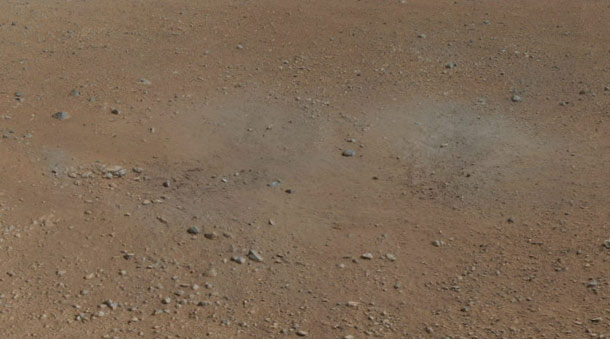Create a free profile to get unlimited access to exclusive videos, sweepstakes, and more!
First color 360-degree panorama from Curiosity

The engineers and scientists at JPL released the first color panorama of Mars taken by Curiosity today! Here it is:
This view is made up of hundreds of small (144 x 144 pixel) thumbnails, so it's not as high res as the images we'll see soon, but it's still very cool. I had to shrink it massively to fit the blog, so click it to see the full-blown 3600 x 750 pixel picture.
You can see parts of the rover around the bottom (remember that this is a bit oddly formatted since it's showing the entire 360° view unwrapped into a rectangular frame), including a wheel at the right. In the middle bottom is the shadow of the mast where the NAVCAMs are (the cameras that took this panorama); that was raised yesterday and appears to be working great. You may be able to see that the surface of the planet is a bit brighter around the mast shadow; that's an optical effect called heiligenschein - literally, "halo" or "holy shine" - and is common when you look at rough, sandy surfaces. Basically, the sand and dust preferentially reflect sunlight back in the direction it came, so the surface looks brighter around the shadow of your head (or in this case, the mast). Also, due to the viewing angle, you don't see shadows around rocks and such on the surface in that direction, so it makes the ground appear brighter.
One thing I want to show in detail though is the patch of Martian surface to the upper right:

This is pretty interesting! The ground may have been disturbed by the rocket exhaust from the skycrane as it hovered over the surface and lowered the rover to the ground. What's revealed here is pure Mars, though! The red color of the planet comes from iron oxide - rust! - in the form of very fine grain dust, like talcum powder. The rocks tend to be basaltic, a grayer color, but they can appear red if they are coated in a layer of the finer dust. If the dust gets blown off, you can see the blue-gray basalt underneath. That happens when dust devils whirl across the landscape, for example, leaving gray curlicues on the reddish-ochre fields.
Under these rocks and dust appears to be bedrock, the floor of Gale crater. Some long-ago impact carved out this 150-km-wide pit, overturning gigatons of rock and basically laying out a geographic history of Mars. That's one big reason this site was chosen; we get all that for free just for going there. And there appears to be lots of evidence of water flow here eons ago; the way the rocks are distributed indicates flowing liquid, for example.
Mind you, as amazing as this image is, it's still low res! We'll be getting more and better pictures as time goes on. And never forget: this was sent by a one-ton nuclear-powered (soon to be) roving laser-eyed chemistry lab set down on another world 250 million kilometers (150 million miles) away!
Oh, the things we do.
Related Posts:
- Video of Curiosity saying bye bye to its heat shield
- Curiosity landing site: the whole mess
- VIDEO of Curiosityâs descent⦠from the rover cam itself!
- Curiosity update: Heat shield spotted!
- Mars orbiter catches pic of Curiosity on its way down!
- Humans send their Curiosity to Mars!



























